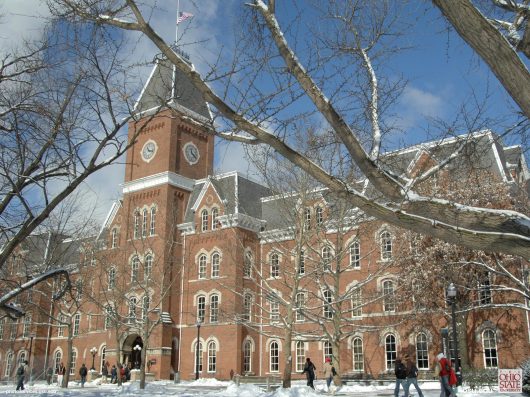
The University Museum, located in University Hall 143, contains artifacts that depict life as an Ohio State student in the early 1900s. Credit: Courtesy of OSU
The University Museum in University Hall holds answers to all kinds of Ohio State-related questions — from how Brutus Buckeye got his name to how Edwin “Tubby” Essington set a precedent for future marching band drum majors.
Established in 2001 and then relocated to its current location in University Hall 143 in 2007, the museum was a collaborative effort between the university archives and Ohio Staters, Inc., an organization that focuses on leadership and giving back to the community, said Catherine Montalto, an OSU associate professor of consumer sciences who serves as faculty treasurer of Ohio Staters, Inc.
The museum space is adorned with several reclaimed pieces, like a blackboard, bricks and teardrop lights from the first University Hall—the first building on OSU’s campus—which opened to students in 1873. The current University Hall was completed in 1976, after being razed in 1971 and entirely rebuilt to look the same as the original on the outside.
Montalto said she has been a member of Ohio Staters, Inc. since 1996, and saw the museum come to life from the ground up. She and other members of Ohio Staters, Inc. worked with university archivists to establish the museum.
Funding for the museum came from about $20,000 worth of investment by Ohio Staters, Inc., Montalto said in a Wednesday afternoon email.
“The building and installation of the museum-quality display cases accounted for about $16,500 of this initial investment,” she said. “In 2007-2008 when the museum was relocated to its current space, Ohio Staters, Inc. spent about $9,000 and most of this spending was for audiovisual equipment, signage and updated displays.”
Ohio Staters, Inc. also pays a $300 annual fee to maintain the University Museum’s security system, Montalto said. Other maintenance and upkeep expenses average about $100 annually, with larger expenses when new displays are created and installed.
Montalto said the university also contributed to the creation and maintenance of the museum, but she did not have records on these costs.
The University Museum is a partnership between Ohio Staters, Inc. and OSU that strives to preserve aspects of the university’s history for future generations of students, Montalto said.
“What you see over there now focuses on undergraduate student life,” she said. “The theme of the museum is about what it’s like to be a student back (in the early 1900s).”
A walk inside the museum allows guests to see university artifacts firsthand, and learn things about OSU they might not have known before, such as:
- Enarson Hall was the first student union. It was constructed in 1909 and had a bowling alley, barber shop, billiard’s room and dining room.
- In 1980, OSU attempted to set the record for the largest musical chair contest with 4,000 participants on the Oval.
- The first residence hall was called “North Dorm” and housed 65 men. It was heated by coal stoves and lit by kerosene lamps.
- Essington, an OSU Marching Band member and drum major from 1920 to 1922, was the first to add baton twirling and flair to a position that was formerly based on strict military discipline.
The museum also houses copies of stories from The Lantern, which were once printed on a university press linotype machine located in Hayes Hall.
Montalto said collaborating with the university archivists helps Ohio Staters, Inc. determine what information to include in the museum.
“The archivists are always great about sharing with us neat things that they think we should bring into the displays,” she said.
University Archivist Tamar Chute said her favorite part of the museum is its accessibility.
“The fact that it’s a useable space is really important to me,” Chute said.
The museum is open during University Hall’s general business hours, and is free and available for people to visit, according to the OSU visitors website.
Montalto said she appreciates students’ interest in the museum.
“I always love it when I see students studying in the museum,” Montalto said. “It is widely open for public use, and rarely scheduled.”
Julia Dagg, a third-year in history and German, said visiting the museum was a great experience that enriched her perception of OSU.
“You learn (about) your school’s roots, plus the beginnings of the university, (which) were some interesting times,” Dagg said. “I think that if you just look at this university and its buildings, and see how old they are and how far we have come, we would have such an appreciation for where we have come from.”
Montalto said she encourages OSU fans, students and alumni to visit the museum and be a part of the university community.
“I think what makes us Buckeyes and part of the Ohio State family are the people who have come before us, and those who will be coming after us,” she said.
Correction: Jan. 7
An earlier version of this story included a photo of a building incorrectly labeled as University Hall, when in fact the building in the photo was Orton Hall.
![Ohio Gov. Mike DeWine signed Senate Bill 1 — a higher education overhaul bill — into law Friday. [Ohio Gov. Mike DeWine speaks at the State of the State address in Columbus. Credit: Joshua Gunter via TNS]](https://www.thelantern.com/files/2025/03/20250204-AMX-US-NEWS-DEWINE-BUDGET-INCREASES-TAXES-FOR-1-PLD-384x253.jpg)

